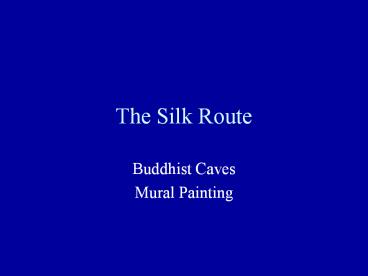The Silk Route - PowerPoint PPT Presentation
Title:
The Silk Route
Description:
Buddhism. Mahayana Buddhism: Western Paradise (Pure Land paradise) spread from India around ... Art and literature flourished; Buddhism was supported by the Kings ... – PowerPoint PPT presentation
Number of Views:2399
Avg rating:3.0/5.0
Title: The Silk Route
1
The Silk Route
- Buddhist Caves
- Mural Painting
2
(No Transcript)
3
(No Transcript)
4
(No Transcript)
5
(No Transcript)
6
Northern Wei and Tang Dynasties
- Northern Wei (Toba) 386-535
- Sui 581-618
- Tang 618-907
7
Buddhism
- Mahayana Buddhism Western Paradise (Pure Land
paradise) spread from India around the 5th
century, Esoteric Buddhism (Tang-7th) and Chan
Buddhism (Song-10th) - Important images are Amida Buddha (Amitabha) who
resides in the Western paradise, Maitreya Buddha
(Future Buddha) and Gyanyin (bodhisattva of
Compassion) - Amida
- Gyanyin (became more feminine from 1279)
- Maitreya laughing pot-bellied Buddha in China
8
(No Transcript)
9
4.12 Colossal Buddha, Cave 20, Yungang Cave, late
5th C. (13.7 m)
10
Yangang Caves
- 50 caves at Yangang began around 460-490
(Capital moved to Luoyang) (contemporary with
Ajanta caves in India) located in Shanxi. - Cave 20 was is one of the oldest caves,
dedicated by the Toba Wei rulers. - The Buddha seated in mediation (fifteen meters)
11
Yungang Cave, late 5th C.
12
Sakyamuni, Yungang Cave
13
Dun Huang caves
- Buddhist caves situated on the Silk Route it is
an important stopping between the N and S tracks
of the Tarim Basin. - They were carved out of natural soft gravel
cliffs approximately a thousand caves but only
half of them survived. - Many were decorated with wall paintings the
themes mainly focus in the Western Paradise of
Amitabha Buddha. - Avalokitesvara (Chinese Gyanyin) became highly
popular
14
4.17 Western paradise, Dunhuang, Tang Dynasty,
late 8th c
15
Avalokistesvara and Gyanyin
- Bodhisattva of Compassion
- He was regarded as the guide of souls and one who
bring the blessing of many children - Reside in the Western paradise of Amithaba
- In Chinese art, he is depicted as a male
bodhisattva, like those of India, until around
the end of the 12th C (early part of Song
Dynasty) - He gradually transform into a male figure with
some female qualities such as the body, the face,
and the hands - By the 17th century (Ming period), the male form
was replaced with more feminine form
16
4.18 Gyanyin as the Guide of Souls, Dunhunag,
10th c.
17
Lotus sutra
- Gyunyin images became feminized represented as a
middle-aged fair lady in a white robe. - The transformation marked the Sinification of
Avalokistesvara by the Chinese who believed in
the Lotus Sutra, which gives Ava the ability to
assume innumerable forms. - She is depicted as a lady in white robe or a
bodhisattva with a thousand hands
18
Gyanyin, 12-13th C.
19
(No Transcript)
20
(No Transcript)
21
Pagoda
- Watchtower-like structure (from clay models made
for the dead to use afterlife) - Represents the center of the earth, axis mundi
- Han period, exterior decorated with paint and
lacquer - Motifs evoke the World outdoors (trees and birds)
22
(No Transcript)
23
(No Transcript)
24
(No Transcript)
25
Great Wild Goose Pagoda
26
Brick Pagoda of Songyuesi, Mt. Song, 520 CE
27
4.16 Isometric view of the timber-framing, main
hall, Foguangsi temple, Shanxi, c. 857
28
(No Transcript)
29
Three-color wares
- They were tomb deposited earthenware with
pigments - They vary in size from animals and tpys a few
inches high to gigantic horses, Bactrian camels,
armed men, dancers, musicians women figurines
were predominate - Human figurines were made in molds, with front
and back cast separately animals were made in
several pieces - They declined after the mid 8th century
30
4.19 Yen Lipen (attributed), Emperor Wu Di, the
Scroll of the Emperors, Tang Dynasty, 7th c.
(11th century copy)
31
Tang period (618-907 CE)
- It is the golden age of Chinese civilization
expanding their territories to Korea, Vietnam,
and Central Asia - Emperors supported trading on the Silk Road
- Emperor Wu Di
- Capitals at Luoyang and Changan (modern Xian)
population of one or two millions it was the
most cultivated metropolitan center in the world - Art and literature flourished Buddhism was
supported by the Kings
32
Court lady figurines, Tang period, 7th century
33
Camel with musicians, Tang period (618-907 CE)
34
Foreign attendants, Tang Dynasty (618-907),
earthernware
35
Girl resting on a camel, Tang period,(618-907),
earthenware with pigments
36
Horse and groom, pottery with polychrome glaze,
Tang Dynasty From Henan






























![[DOWNLOAD]PDF The Silk Roads: A New History of the World PowerPoint PPT Presentation](https://s3.amazonaws.com/images.powershow.com/10108946.th0.jpg?_=202408250611)
![[DOWNLOAD]PDF The Silk Roads: A New History of the World PowerPoint PPT Presentation](https://s3.amazonaws.com/images.powershow.com/10134769.th0.jpg?_=20240921031)